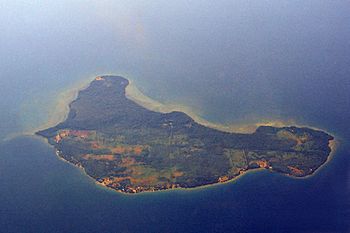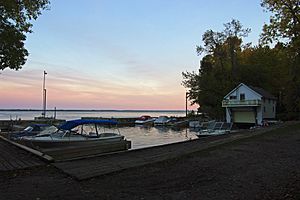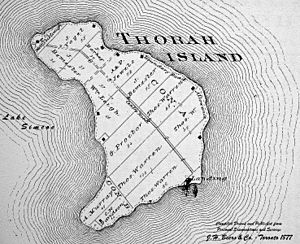Thorah Island facts for kids
 |
|
| Geography | |
|---|---|
| Location | Lake Simcoe |
| Administration | |
|
CAN
|
|
| Province | Ontario |
| Region | Durham |
| Municipality | Brock |
Thorah Island is a cool island in Lake Simcoe, Canada. It's about 4 kilometers (2.5 miles) west of a town called Beaverton in Ontario. The island is pretty big, about 1,450 acres (6 square kilometers). Most of it is covered in trees and swampy forests. Some parts were used for farming or fun activities, but now many of those areas are growing wild again. A dirt path called Centre Road goes across the island from east to west. On the east side, there's a small harbor right across from Beaverton. You can find sandy beaches on the west side, but most of the island's edge is rocky.
Contents
The History of Thorah Island
Thorah Island, along with three other islands in Lake Simcoe, was once home to the Chippewa people. In 1856, they agreed to let the British Crown sell the land. The money from the sales was meant to be invested for the future generations of the Chippewa chiefs. After this agreement, William Napier made the first official map of the island in 1856.
Early Visitors and Residents
Thorah Island became a popular spot for fun in the late 1800s. A group of four businessmen from Toronto would come to the island to camp and fish. By 2005, the island had a seasonal population of 147 people. This group included some family members of those original businessmen.
Thorah Island's Other Names
The island has had a few different names over time. In 1793, Governor John Graves Simcoe called it Canise Island. He did this to honor a local Native chief named Canise. In the agreement between the Native people and the British, the island was known as Plum Island. However, today, most people only call it Thorah Island.
Thorah Island and Honey Bees
Today, Thorah Island is used for a very special purpose. The Honey Bee Research Centre at the University of Guelph uses it as a special place for bees to mate. They keep certain types of Buckfast Bee lines there. Because the island is isolated, it helps them keep these bee lines pure for research.



